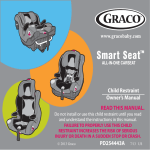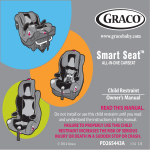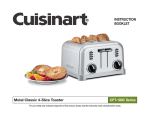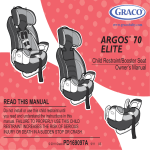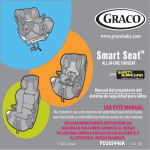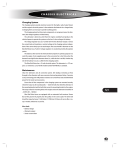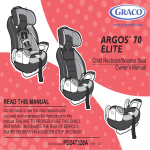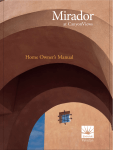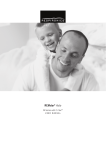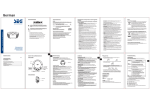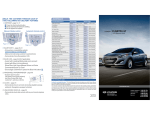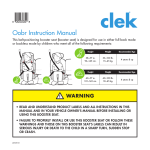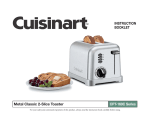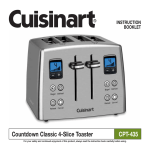Download Graco PD238744A Car Seat User Manual
Transcript
Smart Seat TM ALL-IN-ONE CARSEAT featuring Child Restraint Owner’s Manual READ THIS MANUAL. Do not install or use this child restraint until you read and understand the instructions in this manual. FAILURE TO PROPERLY USE THIS CHILD RESTRAINT INCREASES THE RISK OF SERIOUS INJURY OR DEATH IN A SUDDEN STOP OR CRASH. © 2013 Graco PD238744A 3/13 US Table of Contents Before you begin 1.0 Warnings to Parents and Other Users 2.0 Registration Information 2.1 Register Your Child Restraint 2.2 For Recall Information 2.3 If You Need Help 3.0 Useful Information 3.1 Certification 3.2 Child Restraint Useful Life 3.3 Second Hand Child Restraint 4.0 Assembly 4.1 Attaching LATCH Storage Compartment 4.2 Attaching Cupholder 5.0 Features 5.1 Child Restraint 5.2 Base 6.0 Height and Weight Limitations 6.1 Rear-Facing with base 6.2 Forward-Facing with base 6.3 Booster WITHOUT base 7.0 Choosing an Appropriate Vehicle Seat Location 7.1 Vehicle Seat Location Requirements 7.2 Vehicle Seat Belt Requirements 7.3 SAFE Vehicle Seat Belt Systems 7.4 For Built-in Harness Only 7.5 WITH or WITHOUT Built-in Harness 7.6 UNSAFE Vehicle Belt Systems 8.0 LATCH 8.1 What is LATCH? 8.2 LATCH System 4 10 10 10 11 11 11 11 11 12 12 12 14 14 16 2 18 19 20 21 22 22 23 23 24 24 25 27 27 29 Installation 30 18.1 32 18.2 18.3 34 36 38 39 39 39 40 40 40 42 43 44 44 45 19.0 19.1 19.2 19.3 19.4 20.0 20.1 20.2 20.3 20.4 21.0 3 Using Recline 46 Securing Child in Child Restraint 48 Placing Child in Child Restraint 48 Check Harness System 50 Adjusting Head Support/Harness Straps 51 Booster Installation 52 Storing Harness 52 Using Child Restraint in Booster Mode 54 Securing Child in Booster Seat and Vehicle 56 Adjusting Head Support in Booster Mode 58 Additional Information 59 Adjusting Armrest 59 Removing Seat Cover 60 Airplane Use 61 Care and Maintenance 61-62 Replacement Parts, Warranty, and Owner’s 64 Manual Storage Table of Contents 9.0 Installing Base Using Vehicle Seat Belt 10.0 Installing Base Using LATCH 11.0 REAR-FACING INSTALLATION 12.0 FORWARD-FACING INSTALLATION 13.0 Tether Use 14.0 Tether and LATCH Storage 14.1 Tether Storage 14.2 LATCH Storage 15.0 Harness System 15.1 Harness Strap 15.2 Chest Clip 15.3 Buckle 15.4 Crotch Strap 16.0 Accessories 16.1 Body Support (on certain models) 16.2 Harness Covers & Crotch Strap Cover (on certain models) 17.0 18.0 1.0 Warnings to Parents and Other Users NEVER PLACE THIS CHILD RESTRAINT IN A VEHICLE SEATING LOCATION THAT HAS A FRONT AIR BAG. If an air bag inflates, it can hit the child and child restraint with great force and cause serious injury or death to your child. Check vehicle owner’s manual for information about side air bags and child restraint installation. 4 t/PDIJMESFTUSBJOUDBOHVBSBOUFFQSPUFDUJPOGSPNJOKVSZJOFWFSZTJUVBUJPO )PXFWFSQSPQFSVTFPGUIJTDIJMESFTUSBJOUSFEVDFTUIFSJTLPGTFSJPVTJOKVSZPS EFBUIUPZPVSDIJME tFAILURE TO PROPERLY USE THIS CHILD RESTRAINT increases the risk of serious injury or death in a sharp turn, sudden stop or crash. Your child’s safety depends on you installing and using this child restraint correctly. Failure to follow these instructions and child restraint labels can result in child striking the vehicle’s interior during a sudden stop or crash. tEVEN IF USING THIS CHILD RESTRAINT seems easy to figure out on your own, it is very important to READ THE OWNER’S MANUAL and the vehicle owner’s manual. t:PVSDIJMETTBGFUZEFQFOETPO 1. CHOOSING THE CORRECT MODE OF USE for the child restraint depending on your child’s size. Infants less than 20 lbs. must use this child restraint rear-facing. 2. SELECTING A SUITABLE LOCATION for the child restraint in your vehicle. Some seating positions, such as those equipped with air bags, may not be safe locations for this child restraint. 3. PROPERLY ROUTING THE VEHICLE SEAT BELT OR LATCH. 5 4. PROPERLY SECURING THE CHILD RESTRAINT IN THE VEHICLE using a seat belt designed to restrain a child restraint or by using LATCH. Many seat belts are NOT safe to use with this child restraint, even though they can easily be threaded through or around the child restraint! Vehicle seat belt system MUST hold child restraint securely. Not all vehicle seat belts can be used with a child restraint. If vehicle seat belt does not hold child restraint securely, read “7.0 Choosing An Appropriate Vehicle Seat Location, p. 22-26”. 5. PROPERLY SECURING YOUR CHILD IN THE CHILD RESTRAINT. tNEVER LEAVE YOUR CHILD UNATTENDED. t YOU MUST READ your vehicle owner’s manual on child restraint use. tREAR-FACINGDIJMESFTUSBJOUNVTUCFQSPQFSMZMFWFMFE t5PPSFDMJOFEDBOSFTVMUJOJOKVSZPSFKFDUJPO t5PPVQSJHIUDBOSFTVMUJOCSFBUIJOHEJóDVMUJFT tNEVER LEAVE CHILD UNATTENDED, even when sleeping. Child may become tangled in harness straps and suffocate or strangle. t"DDPSEJOHUPBDDJEFOUTUBUJTUJDTCHILDREN ARE SAFER WHEN PROPERLY RESTRAINED IN REAR VEHICLE SEATING POSITION, RATHER THAN FRONT SEATING POSITIONS. For a vehicle with a front passenger air bag, refer to your vehicle owner’s manual as well as these instructions for child restraint installation. tSECURE CHILDREN in rear seat of vehicle whenever possible. 6 tSERIOUS CRIPPLING INJURY OR DEATH can result if infant faces front of vehicle. The American Academy of Pediatrics (AAP) recommends that children be SFBSGBDJOH until age 2 or until they reach the maximum SFBSGBDJOH height and weight rating for their seat. tSOME SPECIAL NEEDS CHILDREN, such as pre-term babies or those who have tested positive for positional apnea, may be at increased risk of suffering CSFBUIJOHPSPUIFSEJóDVMUJFTJOBDIJMESFTUSBJOU*GZPVSDIJMEIBTTQFDJBMOFFET we recommend that you have your physician or hospital staff evaluate your child and recommend the proper child restraint or car bed before using this product. tDO NOT remove LATCH system from child restraint. If using vehicle seat belt to secure child restraint, LATCH connectors must be stored. (see section “14.0 TETHER AND LATCH STORAGE, p. 39”.) tNEVER ATTACH two LATCH connectors to one vehicle lower anchor point unless specifically allowed by the vehicle manufacturer. 7 tDO NOT INSTALL OR USE THIS CHILD RESTRAINT AND BASE UNTIL YOU READ AND UNDERSTAND THE INSTRUCTIONS IN THIS MANUAL AND IN YOUR VEHICLE OWNER’S MANUAL. DO NOT let others install or use the child restraint unless they understand how to use it. tIF CHILD RESTRAINT IS IN A CRASH, it must be replaced. DO NOT use it again! A crash can cause unseen damage and using it again could result in serious injury or death. DO NOT use child restraint if it is damaged or missing parts. DO NOT use a cut, frayed or damaged child restraint harness, vehicle seat belt or LATCH belts. tNEVER LEAVE A CHILD RESTRAINT and base unsecured in your vehicle. An unsecured child restraint or base can be thrown around and may injure occupants in a sharp turn, sudden stop or crash. Remove it or make sure that it is securely belted in the vehicle. If not using LATCH, make sure unsecured LATCH connectors are properly stored on base. tNEVER GIVE THIS CHILD RESTRAINT to someone else without also giving them this manual. 8 tDO NOT use accessories or parts other than those provided by Graco. Their use could alter the performance of the child restraint. tNEVER USE A SECOND-HAND CHILD RESTRAINT or a child restraint whose history you do not know. tDO NOT MODIFY YOUR CHILD RESTRAINT or use any accessories or parts supplied by other manufacturers. tTHE CHILD RESTRAINT CAN BECOME VERY HOT IF LEFT IN THE SUN. Always touch the surface of any metal or plastic parts before putting your child in the child restraint. tDO NOT use child restraint with any stroller. tDO NOT allow the liquid in the level indicator to be ingested or come into contact with the eyes. 9 Model Number: Date of Manufacture: Purchase Date: 2.0 Registration Information 2.1 Register Your Child Restraint Please fill in the above information. The model number and date of manufacture can be found on a label on the child restraint. Fill out the prepaid registration postcard attached to the harness and mail it today. Child restraints could be recalled for safety reasons. You must register this restraint to be reached in a recall. Send your name, address, and the restraint’s model number and date of manufactureUP Graco Children’s Products Inc. Attn: Customer Service, 3 Glenlake Parkway, Atlanta, GA 30328 or call 1-800-345-4109 or register online at: http://www.gracobaby.com/carseatregistration 2.2 For Recall Information $BMMUIF64(PWFSONFOUT7FIJDMF4BGFUZ)PUMJOFBU 55: PSHPUPIUUQXXX/)54"HPWPSDPOUBDU(SBDP 1-800-345-4109 or www.gracobaby.com 10 2.3 If You Need Help 3.2 Child Restraint Useful Life STOP using this child restraint and throw it away 10 years after the date of manufacture. Look for this TUJDLFSPOSFBSPGDIJMESFTUSBJOU MODEL Date of Manufacture NAME year month day GRACO CHILDREN'S PRODUCTS, INC. ATLANTA, GA 30328 1-800-345-4109 Made in China PD206938A 3.1 Certification THIS CHILD RESTRAINT CONFORMS to all applicable requirements of Federal Motor Vehicle Safety Standard 213 and is certified for use in motor vehicles. 3.3 Second Hand Child Restraint Graco Children’s Products Inc. advises against loaning or passing along a child restraint. 11 3.0 Useful Information Please contact our Customer Service Department with any questions you may have concerning parts, use, or maintenance. When you contact us, please have your product’s model and date of manufacture ready so that we may help you FóDJFOUMZ5IFTFOVNCFSTDBOCFGPVOEPOBMBCFMPOUIFDIJMESFTUSBJOU USA: 1-800-345-4109 or www.gracobaby.com www.cpsc.gov www.NHTSA.gov www.seatcheck.org 4.1 Attaching LATCH Storage Compartment NEVER use without LATCH storage compartment or cupholder attached. 4.0 Assembly P D1 59905A t*OTFSULATCH storage compartment under metal tube into bottom of base as shown A. t-JOFUBCTPOCPUUPNPGLATCH storage compartment with openings in child restraint B. t1VTIJOUPCBTFVOUJMZPVIFBSBDMJDLC. 4.2 Attaching Cupholder NEVER place sharp or pointed objects in a cupholder. In a crash, these objects could hit your child and cause serious injuries. t3FNPWFTFBUQBEGSPNSJHIUIBOETJEFPGUIFDIJMESFTUSBJOUBTDIJMETJUTJO restraint D. t*OTFSUDVQIPMEFSJOUPPQFOJOHJODIJMESFTUSBJOUE. t3PUBUFDVQIPMEFSEPXOVOUJMZPVIFBSBDMJDLUPMPDLJOUPQMBDFF. t8SBQTFBUQBECBDLBSPVOEDVQIPMEFSBOETJEFPGDIJMESFTUSBJOUG. t5VDLGBCSJDBSPVOEDVQIPMEFSBOEMPDLLOPCH. 12 CLICK! A B C CLICK! D E G H 13 F 5.1 Child Restraint N M A L O 5.0 Features B J C P I D K E H F G 14 Q A B C D E F G H I J K L M N O P Q Harness slots Harness buckle Crotch strap Cupholder Harness release lever Harness adjustment strap Recline handle Lock knobs Armrest Chest clip Harness strap Level indicator Head support Head support release Tether storage Tether * Instruction manual storage *Vehicles are now (or can be) equipped with tether anchor points behind some seats. A tether anchors the top of the child restraint to the body of the vehicle. When used properly with the vehicle seat belt or LATCH, a tether helps reduce injury in a sudden stop or crash. 15 5.2 BASE X R 5.0 Features W S V U T NOTE: Only use base with Smart Seat™ All-In-One Carseat. Y 16 Z R S T U V W X Y Z **United States Federal Motor Vehicle Safety Standards have defined a system for installing child restraints in vehicles. The system is called LATCH. LATCH may ONLY be used IN PLACE of vehicle belt if vehicle is equipped with LATCH anchor points. Please refer to vehicle owner’s manual for LATCH in vehicles. Vehicle belt/LATCH path Child restraint pin guides Lock identification window LATCH connector LATCH adjustment belt LATCH belt ** Seat belt lock-off LATCH storage compartment LATCH (stored) 17 6.0 Height & Weight Limits FAILURE TO USE CHILD RESTRAINT IN A MANNER APPROPRIATE FOR YOUR CHILD’S SIZE MAY INCREASE THE RISK OF SERIOUS INJURY OR DEATH. Instructions for the use of this child restraint differ greatly depending on the size of your child. Be sure you are using the child restraint in the correct mode and with the correct features for your child. 3FBS'BDJOH 4 lbs-20 lbs XJUICBTF (1.8 kg-9 kg) 20 lbs-40 lbs (9 kg-18.1 kg) and and up to Top of head 1 year AT LEAST 1” MUST BE (2.54 cm) REAR BELOW top of FACING head support 'PSXBSE'BDJOHXJUICBTF Body support MUST be used if shoulders are below lowest harness setting. 40 lbs-65 lbs 20 lbs-39 lbs (18.1 kg-29.5 kg) (9 kg-17.7 kg) MAX HEIGHT At least 1 year old and can 50” (127 cm) sit upright Shoulders are unassisted BELOW top harness slot position #PPTUFSWITHOUT#BTF 65 lbs-100 lbs 30 lbs-65 lbs (29.5 kg-45 kg) (13.6 kg-29.5 kg) MIN. HEIGHT MAX. HEIGHT 38” (96 CM) 57” (145 CM) IF Shoulders are Top of ears are BELOW ABOVE top top of booster seat harness slot position approx. 3-10 years 18 3FBSGBDJOHXJUICBTFUPMCT,H t*OGBOUTXIPXFJHIMFTTUIBOMCTLH BOEBUMFBTUZFBS 1” (2.54 cm) of age MUST be SFBSGBDJOH. t*OGBOUTPSUPEEMFSTUPMCTUPLH NBZCF SFBSGBDJOH. t)BSOFTTIFJHIUNVTUCFCFMPXDIJMETTIPVMEFST *.1035"/5 This child restraint is certified for use SFBSGBDJOH with children up to 40 lbs. (18.1 kg). However, some children approaching 40 lbs. (18.1 kg) may be too tall to fit SFBSGBDJOH. Top of head must be at least 1” (2.54 cm) below the top of the head support. t$IJMETIPVMEVTFDIJMESFTUSBJOUGPSXBSEGBDJOH only if child is over 20 lbs. (9 kg) and can sit upright unassisted. (*) *The American Academy of Pediatrics (AAP) recommends that children be SFBSGBDJOH until age 2 or until they reach the maximum SFBSGBDJOH height and weight rating for their seat. Preterm or Low Birthweight Infants A preterm infant or low birth weight infant may be at special risk in a vehicle or aircraft. According to the American Academy of Pediatrics, these infants may suffer CSFBUIJOHEJóDVMUJFTJGJNQSPQFSMZSFDMJOFEJOBDIJMESFTUSBJOU Graco advises that you have your physician or hospital staff evaluate your infant and recommend the proper child restraint or car bed before you and your infant leave the hospital. 19 'PSXBSEGBDJOHXJUICBTFUPMCTUPLH WITH BUILT-IN HARNESS SYSTEM: t$IJMENVTUOPUFYDFFEJODIFTDN t"UMFBTUPOFZFBSPME t5PEEMFSTUPMCTUPLH XIPBSFDBQBCMF of sitting upright unassisted may beGPSXBSEGBDJOH. If unable to sit upright unassisted, use SFBSGBDJOHwhen below 40 lbs. (*) t5PEEMFSTUPMCTUPLH BOEVQUPJODIFT (127 cm) tall MUST be GPSXBSEGBDJOH. t4IPVMEFSTBSFBELOW top harness slot/head support height. If shoulders are above harness slots, child is too large for GPSXBSEGBDJOHwith built-in harness. (*, see p. 19 American Academy of Pediatrics (AAP) recommendations) 20 #PPTUFS8*5)065CBTFUPMCTUPLH WITHOUT BUILT-IN HARNESS SYSTEM: Harness MUST be stored during Booster mode, see “19.1 Storing Harness, p. 52”. t)FJHIUUPJODIFTBOEDN t"QQSPYJNBUFMZZFBSTPGBHF t5IFTIPVMEFSCFMUMUST lie across child’s shoulder as shown and the lap portion of the belt is positioned low on the child’s hips. t$IJMETFBSTBSFBELOW top of head support. If tops of ears are above top of head support, child is too large for booster seat. t*GDIJMEJTCFUXFFOBOEMCTBOELH BOE shoulders are below the upper harness slots, we highly recommend using in forward-facing mode with built-in harness for as long as possible (up to 65 lbs). 21 7.0 Choosing an Appropriate Vehicle Seat Location 7.1 Vehicle Seat Location Requirements IMPROPER PLACEMENT OF THE CHILD RESTRAINT INCREASES THE RISK OF SERIOUS INJURY OR DEATH. Some seating positions in your vehicle may not be safe for this child restraint. Some vehicles do not have any seating positions that can be used safely with the child restraint. If you are not sure where to place the child restraint in your vehicle, consult your vehicle owner’s manual or call Graco Children’s Products Inc., at 1-800-345-4109. tChildren are safer when properly restrained in rear vehicle seating positions. Whenever possible secure the child restraint in the center position of the seat directly behind the front seats. However, this position is sometimes equipped with a lap belt only and cannot be used when this child restraint is used without the built-in harness. 22 t5IFWFIJDMFTFBUNVTUGBDF forward. Do not use child restraints on rear-facing or side-facing vehicle seats. 7.2 Vehicle Seat Belt Requirements MANY SEAT BELT SYSTEMS ARE NOT SAFE TO USE WITH THE CHILD RESTRAINT. THE VEHICLE SEAT BELT MUST BE DESIGNED TO HOLD THE CHILD RESTRAINT TIGHTLY AT ALL TIMES. DO NOT USE A VEHICLE BELT THAT CHANGES LENGTH WHILE DRIVING. Pay careful attention to these systems; some of the seat belts that are not safe to use look very much like seat belts that are safe to use. If you are unsure, consult your vehicle owner’s manual or call Graco Children’s Products Inc., at 1-800-345-4109. 7.3 SAFE Vehicle Seat Belt Systems THE FOLLOWING BELT SYSTEMS CAN BE USED WITH YOUR CHILD RESTRAINT, IF the seat location meets all other requirements of these instructions and those in your vehicle owner's manual. LATCH can be used in place of the following vehicle belt systems if your vehicle is equipped with LATCH anchor points. Please refer to vehicle owners manual for LATCH locations. 23 7.4 For Built-in Harness Only t Lap Belts - Manually adjusted when buckled, the belt is tightened manually by pulling on the free end. t Lap Belts with Automatic Locking Retractor (ALR) - The automatic locking retractor will not permit the lap belt to lengthen once it is buckled. Tighten the belt by feeding the belt back into the retractor while pushing down hard on the child restraint. 7.5 With or Without Built-in Harness t Combination Lap/Shoulder Belt with t Combination Lap/Shoulder Locking Latch Plate - Once it is buckled, this Belt with Sliding Latch Plate type of belt has a latch plate that will not This belt has a latch plate that allow the lap portion of the belt to loosen. Belt slides freely along the belt. is tightened by pulling hard on the shoulder portion of the vehicle belt while pushing down hard on the child restraint. 24 7.6 UNSAFE Vehicle Belt Systems DO NOT USE ANY OF THE FOLLOWING SYSTEMS TO SECURE THE CHILD RESTRAINT. LATCH can be used IN PLACE OF the following unsafe belt systems if your vehicle is equipped with LATCH anchor points. Please refer to the vehicle owners manual for LATCH locations. NEVER USE unsafe belt systems. t Lap Belts with Emergency Locking Retractor (ELR) This lap belt stays loose and can move until it locks in a crash or sudden stop. t Combination Lap/Shoulder Belt with Retractor Each strap has a retractor at one end and is attached to the latch plate at the other end. t Passive Restraint - Lap or Shoulder Belt Mounted on Door 25 t Passive Restraint Lap Belt with Motorized Shoulder Belt DO NOT use vehicle belts that are attached to the door in any way or that move along a track to automatically surround the passenger when the door is closed. t Lap Belts Forward of Seat Crease Vehicle seat belts located forward of seat crease may not securely hold child restraint. Check vehicle owner’s manual or see vehicle dealer for car seat installation requirements. tIf approved for use with child restraint, install child restraint and check for secure installation by pulling child restraint front to back. If child restraint slides forward, DO NOT use these seat belts. 26 8.1 What is LATCH? 27 8.0 LATCH United States Federal Motor Vehicle Safety Standards have defined a system for installing child restraints in vehicles. The system is called LATCH. LATCHTUBOETGPS Lower Anchors and Tethers for CHildren. LATCH in the vehicle consists of a top tether anchor point and two lower anchor points. Some vehicle owner manuals use the term ISOFIX to identify the new child restraint anchor system. This child restraint with LATCH can also be used in vehicle seating positions equipped with ISOFIX. Newer vehicles have one or more seating positions with LATCH anchor points. If vehicle is equipped with LATCH, the vehicle lower anchor points may be visible at the vehicle seat crease. If not visible, they may be marked with this symbol . CHECK vehicle owner’s manual for vehicle top tether anchor locations. They may be identified using one of the anchor symbols as shown . ONLY use LATCH on a child restraint in a seating position recommended by vehicle manufacturer. NOTE: Some vehicle manufacturers have lower maximum weight ratings for LATCH anchors, so you must consult your vehicle owner’s manual or call the vehicle manufacturer to confirm the limits on your vehicle’s LATCH anchors. Use vehicle belt (not LATCH connectors) for installations with children weighing more than 48 pounds (21.7 kg). 4FFZPVSWFIJDMFPXOFST NBOVBMGPSFYBDU MPDBUJPOTBODIPS JEFOUJGJDBUJPOBOE SFRVJSFNFOUTGPSVTF XJUIBDIJMESFTUSBJOU 7FIJDMF5PQ5FUIFS "ODIPS1PJOUT 7FIJDMF-PXFS "ODIPS1PJOUT Typical seat in a passenger vehicle. Other vehicle types may have different -"5$) locations. 7FIJDMF 4FBU$SFBTF 28 8.2 LATCH System LATCH consists of a permanently attached lower anchor belt and a top tether strap. ONLY use LATCH in a seating position recommended by vehicle manufacturer. LATCH lower vehicle anchor points are defined as 11 inches from the center of one LATCH anchor to the center of another LATCH anchor. If allowed by your Vehicle Owners Manual, the center seating position maybe used if the anchor spacing is 11” or greater. REAR-FACING FORWARD-FACING Vehicle Top Tether Anchor Point Vehicle Lower Anchor Points Lower Anchor Belt Vehicle Lower Anchor Points 29 Child Restraint Top Tether Lower Anchor Belt 9.0 Installing Base Using Vehicle Seat Belt You must carefully follow the instructions provided by your vehicle manufacturer, in addition to the information in this manual. Before proceeding be sure you have read and understood, i$IPPTJOHBO"QQSPQSJBUF7FIJDMF4FBU -PDBUJPOwPOQBHFT Make sure vehicle is on level ground A and not like in picture B. If a front passenger seat is used TFFBJSCBHXBSOJOHQBHF , slide the vehicle seat rearward as far as possible from the dashboard. If a rear seat is used, make sure the seat in front of it is moved forward enough and is upright enough to allow room for the child restraint. When using the vehicle seat belts to install the base, the lock-off is ALWAYS used to secure both belts of the lap or lap/shoulder belt. 1. Position base in vehicle seat as shown C. 2. Open the lock-off and route the vehicle belt through the belt path and over the lock-off D. 3. Buckle seat belt. Pull up on shoulder belt while pushing down on base to tighten E. 4. Close lock-off F. 5. Test base for secure installation by moving front to back and left to right at the belt path G. Base should not move more than 1 inch ( 2.54 cm). If belt loosens or lengthens, repeat procedure. Lap Belt H and Lap/Shoulder Belt I should appear as shown when installed. 30 A B C E F Lap Belt Lap/Shoulder Belt Vehicle Belt D G H 31 I 10.0 Installing Base Using LATCH 1. Remove LATCH from storage area A. For ease of installation, extend LATCH to its maximum length. 2. Place base in vehicle seat as shown B. 3. Make sure LATCH is routed through vehicle/LATCH belt path normally used for vehicle seat belt. Belt must lay flat and not be twisted. 4. Hook Connectors to vehicle lower anchors. Pull firmly on Connectors to be sure they are attached C. 5. NEVER put two LATCH connectors on one vehicle LATCH anchor unless specifically allowed by the vehicle manufacturer D. 6. With base flat on vehicle seat, slide back until top of base contacts seat back. Make sure that base bottom remains flat on the vehicle seat E. 7. Tighten LATCH by pushing down hard on the center of the base and pulling the free end of the adjustment belt F. 8. Test base for secure installation by moving front to back and left to right at the belt path G. Base should not move more than 1 inch ( 2.54 cm). If belt loosens or lengthens, repeat procedure. 9. Check that the LATCH stays tight and does not slip from the tightened position. If it does not stay tight, try another seating position or contact Graco at 1-800-345-4109. 10. To remove LATCH lift up on metal tongue of buckle and remove LATCH as shown H. 32 A B D G E H 33 C F 11.0 REAR-FACING INSTALLATION 1. Test base for secure installation. See TFDUJPOTBOE GPSCBTFJOTUBMMBUJPOQ A. 2. Push in B and rotate knobs C on both sides of child restraint at the same time to unlock position. 3. Place child restraint on base in rear-facing position D. 4. Rotate knobs on both sides of child restraint to lock it into base E. You will see lock symbols in windows on side of base as shown H. 5. If you see the red flags up in the child restraint seating area F and you see the unlock symbol I then seat is not secured to base. 6. Check seat is secure by moving front to back and left to right at the belt path G. Base should not move more than 1 inch ( 2.54 cm). If belt loosens or lengthens, repeat procedure. NOTE: Make sure tether is stored. See i5FUIFS 4UPSBHFwQ. You can not use tether in rear-facing mode. NOTE: Bubble in level indicator must be fully between the two lines J. Level indicator is for rear-facing use only. See i6TJOH3FDMJOFwQ A D F 34 B C J E LOCKED G H 35 UNLOCKED I 12.0 FORWARD-FACING INSTALLATION 1. Test base for secure installation. See TFDUJPOTBOE GPSCBTFJOTUBMMBUJPOQ A. 2. Push in B and rotate knobs C on both sides of child restraint to unlock position. 3. Place on base in forward-facing position D. 4. Rotate knobs on both sides to lock seat to base E. You will see lock symbols in windows on side of base as shown H. 5. If you see the red flags up in the child restraint seating area F and you see the unlock symbol I then seat is not secured to base. 6. Check seat is secure by moving front to back and left to right at the belt path G. Base should not move more than 1 inch ( 2.54 cm). If belt loosens or lengthens, repeat procedure. A D Note: See i5FUIFS6TFwQ to attach tether. F 36 B C Tether E LOCKED G H 37 UNLOCKED I 13.0 TETHER USE All LATCH seating positions have tether anchors. Always use tether if a vehicle tether anchor is available in forward-facing mode with harness. Check your vehicle owner’s manual for the tether anchor location(s). If your vehicle is not equipped with a tether anchor, it may be possible to install one. Contact your vehicle dealership for the proper anchor location and installation. A NOTE: TETHER NOT TO BE USED IN REAR-FACING MODE. 1. Check that tether is securely attached to child restraint. 2. Fasten tether clip to anchor point A. B 3. Tighten adjustment belt to remove any slack B. 4. To loosen, push button while pulling on the belt as shown C. C 38 14.1 Tether Storage Tether must be stored to child restraint for rear-facing use. t1VMMMPPTFFOEPGBEKVTUNFOUTUSBQUPSFNPWFBOZ slack. t3PMMMPPTFFOEPGBEKVTUNFOUTUSBQVQBOETFDVSFXJUI a rubber band. A 14.2 LATCH Storage t5PTUPSFLATCH belt, insert into LATCH storage compartment on back of seat B. P D1 59905A B 39 14.0 TETHER AND LATCH STORAGE t4UPSFUFUIFSPO%SJOHPOTFBUQBEBTTIPXOA. 15.1 Harness Straps t5PUJHIUFO1VMMIBSOFTTBEKVTUNFOUTUSBQA. t5PMPPTFO-JGUMFWFSB while pulling shoulder harness straps C. Harness Strap 15.0 HARNESS SYSTEM 15.2 Chest Clip t5PPQFO1SFTTUBCTBOEQVMMBQBSUD. t5PDMPTF4OBQIBMWFTUPHFUIFSE. Make sure the chest clip is locked by pulling out on each half. Chest Clip Buckle Crotch Strap Harness Adjustment Strap 40 A B D E 41 C 15.3 Buckle t5PCVDLMF*OTFSUCPUI tongues into buckle. Pull up on tongues to be sure they are locked F. 5PUJHIUFO1VMMIBSOFTT adjustment strap G. t5PVOCVDLMF-PPTFOCZ lifting lever and pulling shoulder harness straps H. Tilt top of buckle toward seat I and press in at the top of the red button J and pull tongues out of buckle K. 42 F G H I J K 15.4 Crotch Strap t$IPPTFUIFDSPUDITUSBQQPTJUJPOUIBUJTDMPTFTU to but not under your child. t1VTIUIFDMJQBUUIFFOEPGDSPUDITUSBQUISPVHI bottom of seat and pull out through the seat and seat cover L. t3FJOTFSUJOPUIFSDSPUDITUSBQPQFOJOHBOEQVTI through seat cover and seat M. CHECK buckle is securely installed by pulling up on crotch strap. The clip must be properly seated. Bottom of child restraint L Bottom of child restraint 43 M 16.0 ACCESSORIES 16.1 Body Support (on certain models) To prevent ejection in sudden stop or crash: t/FWFSBMMPXCPEZTVQQPSUUPCVODIPSGPMECFIJOEDIJME t0OMZVTFCPEZTVQQPSUJOSFBSGBDJOHNPEF t#PEZTVQQPSU.645CFVTFEJGTIPVMEFSTBSFCFMPX lowest harness setting. DO NOT use with children over 20lbs. Flip body support and head pillow over. Slide head pillow under elastic strap on back of body support as shown A. Do not use head pillow and body support with any other product. Place in seat as shown. 44 Strap A 16.2 Harness Covers & Crotch Strap Cover (on certain models) To prevent serious head injury in sudden stop or crash: t"MXBZTNBLFTVSFTIPVMEFSTUSBQTBSFQSPQFSMZQPTJUJPOFEPOTIPVMEFST t.BLFTVSFUIBUIBSOFTTDPWFSTEPOPUJOUFSGFSFXJUIQMBDFNFOUPGUIFDIFTUDMJQ at armpit level. t)BSOFTTDPWFSTBSFPOMZUPCFVTFEJOSFBSGBDJOHNPEF DO NOT use with children over 20lbs. A Pull buckle through crotch strap cover as shown A. B Wrap harness covers around the harness straps. Fasten hook and loop tape B. 45 FAILURE TO PROPERLY recline the infant restraint on the vehicle seat increases the risk of serious injury or death. Recline only works in modes where child restraint is attached to the base. 17.0 USING RECLINE REAR-FACING FORWARD-FACING 1. Pull up on recline button on front of child restraint A. 2. Bubble in level indicator C must be If using seat with child 40-65lbs, fully between the two lines D. E is always use recline position 1. not level. 3. Vehicle must be on level ground and 1. Pull up on recline button on front of child in child restraint when checking child restraint B. level indicator. 2. Adjust recline to desired level NOTE: Level indicator is for indicated on label F on side of rear-facing use only. base F. 46 REAR FACING FORWARD-FACING A B NOT LEVEL C D E USE LEVEL I N D I C ATO R F O R P R O P E R I N S TA L L AT I O N 5 WARNING F 4 2 PD24 CING 20–39 LBS. 3 if using seat with ch ild 40-65lbs, always use recline p osition . 47 A 6867 R E A R - FA C I N G 4 – 4 0 L B S . F O R WA R D - FA 1 S. 20–65 LB F 18.0 SECURING CHILD IN CHILD RESTRAINT 18.1 Placing Child in Child Restraint 1. Place child in child restraint A with child’s back flat against back of child restraint. Avoid bulky clothing. 2. Place harness straps over child’s shoulders and insert tongue(s) into buckle B. 3. Pull up on tongue(s) to be sure they are locked. 4. Close chest clip C Position chest clip at arm pit level. 5. Pull on harness adjustment strap to tighten straps as shown D. A snug strap should not allow any slack. It lies in a relatively straight line without sagging. It does not press on the child’s flesh or push the child’s body into an unnatural position. 6. SAFETY CHECK : a) MAKE SURE the top of the child’s head is at least 1” (2.54 cm) below the top of the infant restraint. b) CHECK that harness straps are not twisted. c) CHECK that the harness is snug. You should NOT be able to pinch E the harness if it is snug. A snug strap should not allow any slack. It lies in a relatively straight line without sagging. It does not press on the child’s flesh or push the child’s body into an unnatural position. 7. A rolled towel can be used on each side to support small children F. Be sure towels do not interfere with harness system. Towels should NOT be placed under child. 48 Chest Clip Buckle Harness adjustment strap 49 A B C D E F 18.2 Check Harness System To prevent serious injury or death: t,FFQIBSOFTTTUSBQTTOVHBOEQPTJUJPOFEPO shoulders with chest clip at arm pit level. t%POPUVTFTUSBQDPWFSTCMBOLFUTDVTIJPOTPS padding under harness straps or child unless provided by Graco. t$IJMETIPVMECFESFTTFEJODMPUIJOHUIBUEPFTOPU interfere with buckling the harness. REAR-FACING t4-40 lbs (1.8-18.1 kg) Harness straps/head support must be in one of the bottom 3 height positions below the shoulders. t)BSOFTTIFJHIUNVTU be below child’s shoulders. t#PEZTVQQPSUMUST be used if shoulders are below lowest harness setting. FORWARD-FACING t20-65 lbs (9.1-29.5 kg) and at least one year old. Harness straps/ head support must be in one of the top 4 height positions, at or above shoulders. 50 t)BSOFTTIFJHIU must be at or just above child’s shoulders. 18.3 Adjusting Head Support/ Harness Straps Failure to properly adjust the harness straps for your child increases the risk of serious injury or death in the event of a sharp turn, sudden stop or crash. tBEFORE adjusting the head support height, have your child lean forward slightly. t4RVFF[FUIFSFEBEKVTUNFOUIBOEMFA on top of seat and pull head support up until it snaps into one of the 6 height positions. t5PMPXFSTRVFF[FSFEBEKVTUNFOUIBOEMF and push head support down. tCHECK to make sure it is securely snapped into one of the 6 height positions by pulling up on head support. When using in rear-facing mode always use one of the bottom 3 height positions B. When using in forward-facing mode always use one of the top 4 height positions B. Refer to page 50 for harness strap placement. 51 A B 19.0 BOOSTER INSTALLATION a19.1 Storing Harness Harness must be stored during Booster Mode. 1. Push the clip at the end of crotch strap through bottom of seat and pull out through the seat and seat cover A. 2. Rotate bottom of head support pad up and attach to back of head support pad with hook and loop tape B. 3. Disconnect snaps on seat cover C. 4. Move harness straps behind seat cover D. 5. Disconnect snaps or hook and loop tape (on certain models) and move shoulder straps behind head support pad E. 6. Open door behind seat cover F. 7. Insert harness buckle and crotch straps into harness storage compartment G. 8. Close door H. 9. Re-attach snaps on seat cover I. 52 Bottom of child restraint A B C D E F G H I 53 19.2 Using Child Restraint in Booster Mode Failure to properly secure your child in the child restraint increases the risk of serious injury or death in the event of a sharp turn, sudden stop or crash. In a crash, the child restraint provides NO protection for your child unless the vehicle lap/shoulder belt is properly secured. Follow these instructions carefully to properly secure your child. t7FIJDMFCFMUTMUST lie flat against child and MUST not be twisted. tNEVER use a vehicle lap-only belt across front of child A. tDO NOT use shoulder belt loose or positioned under arm B. tDO NOT place shoulder belt behind child’s back C. t-BQQPSUJPOPGMBQTIPVMEFSCFMUMUST be low and snug on hips, just touching thighs. tDO NOT allow child to slide down in booster seat D. t*GDIJMEXJMMOPULFFQWFIJDMFCFMUQSPQFSMZQPTJUJPOFEDO NOT use this booster seat. Use a different child restraint system. tDO NOT position vehicle belt over top of the armrests E. t7FIJDMFTFBUIFBETVQQPSUTIPVMEOPUDSFBUFBHBQCFUXFFOWFIJDMFTFBUBOE booster seat F. The front of booster seat MUST NOT hang over front of vehicle seat G. tDO NOT place child in booster if flags are up in the seat area H. tDO NOT use in Booster mode with base I. 54 A B C D E F G H I 55 19.3 Securing Child in Booster Seat and Vehicle USE ONLY the vehicle lap and shoulder belt system when restraining the child in the booster seat. 1. Remove base from vehicle seat A. 2. Place booster seat firmly against the back of a forward-facing vehicle seat equipped with a lap/shoulder belt only B. 3. Place child in booster seat with child’s back flat against back of booster seat. 4. Position lap/shoulder belt through shoulder belt guide C not underneath shoulder belt guide. Fasten buckle and pull up on the shoulder belt to tighten. Be sure lap portion of the belt goes under armrests D. 5. If shoulder belt lies across child’s neck, head or face, redirect shoulder belt over shoulder by adjusting the head support setting, see i"EKVTUJOH )FBE4VQQPSUJO#PPTUFS.PEFwQ 6. The shoulder belt MUST lie across child’s shoulders in red zone as shown E. 56 Armrest Shoulder belt A Lap belt B C D 57 E 19.4 Adjusting Head Support in Booster Mode When using in booster mode always use one of the top 4 height positions A. tBEFORE adjusting the head support height, have your child lean forward slightly. t4RVFF[FUIFSFEBEKVTUNFOUIBOEMFB on top of seat and pull head support up until it snaps into one of the 4 height positions. t5PMPXFSTRVFF[FSFEBEKVTUNFOUIBOEMF and push head support down. tCHECK to make sure it is securely snapped into one of the 4 height positions by pulling up on head support. tFOR PROPER FIT: The shoulder belt guides should be even with or just above the shoulders C. A B C 58 20.1 Adjusting Armrest Armrest can be adjusted by pushing up or down on it A. 59 20.0 Additional Information A 20.2 Removing Seat Cover 1. Store harness seei4UPSJOH )BSOFTTwQ. 2. Remove elastic loops from seat as indicated in A. 3. Pull off cover taking care around the lock knobs, recline handle, level indicator and cup holder. 4. Machine wash cover in cold water on delicate cycle and drip-dry. DO NOT USE BLEACH. 5. To put the seat cover back on, reverse preceding instructions. Elastic loops 2X A 60 20.3 Airplane Use t5IJTDIJMESFTUSBJOUTZTUFNDPOGPSNTUPBMMBQQMJDBCMF Federal Motor Vehicle Safety Standards. t5IJT3FTUSBJOUJT$FSUJGJFEGPS6TFJO.PUPS7FIJDMFT t5IJT3FTUSBJOUJTNOT Certified for Use in Aircraft. 20.4 Care and Maintenance t$POUJOVPVTVTFPGDIJMESFTUSBJOUNBZDBVTFEBNBHFUPWFIJDMFTFBU6TFBDIJME restraint mat, towel or thin blanket to protect upholstery. t.FUBMBOEQMBTUJDQBSUTDMFBOXJUINJMETPBQBOEDPPMXBUFS/PCMFBDIPS detergents. t)BSOFTTTUSBQTBOELATCHTUSBQTTQPUDMFBOXJUIEBNQTQPOHF%POPUJNNFSTFUIF straps in water. Doing so may weaken the straps. t*GCVDLMFPSIBSOFTTBEKVTUFSTUJDLTPSXJMMOPUSFNBJOUJHIUDIFDLGPSGPSFJHOPCKFDUT such as food, dirt, etc. Remove objects with tweezers and/or clean with a cotton swab. If you cannot get the harness to remain tight with the buckle securely locked, do not use this child restraint. 61 Buckle Cleaning Process: Bottom of child restraint WARNING Prevent serious injury or death: t#VDLMFNVTUCFQSPQFSMZMBUDIFE t1FSJPEJDBMMZJOTQFDUBOEDMFBOCVDLMFUPSFNPWF objects or debris that could prevent latching. B 1. Turn restraint over, push retainer through crotch strap slot (a). 2. To clean buckle - place in a cup of warm water and gently agitate the buckle, press the red button several times while in the water (b). DO NOT SUBMERGE THE HARNESS WEBBING. DO NOT USE SOAPS or LUBRICANTS. DO NOT use household detergents. Never lubricate buckle. 3. Shake out excess water and allow to air dry, harness webbing should be dry before use (c). 4. Repeat Step 2 and 3 as needed. Buckle should fasten with a “click”. 5. Re-attach buckle into the same slot from Step 1. Re-check harness for correct installation before use. 62 C D Notes 63 21.0 Replacement Parts, Warranty, and Owner’s Manual Storage To purchase parts or accessories or for warranty information in the United States, please contact us at the following: www.gracobaby.com or 1-800-345-4109 Store instruction manual in the space provided on back of seat. 64 ALL-IN-ONE CARSEAT
































































